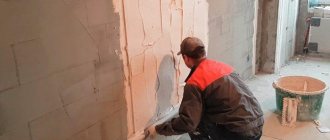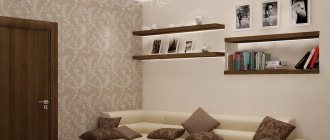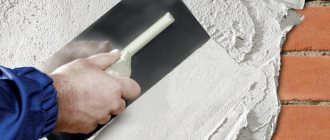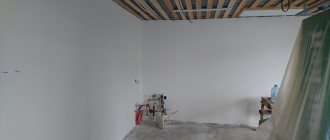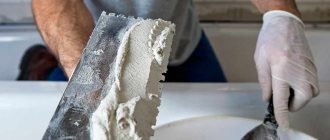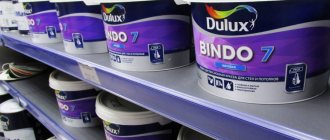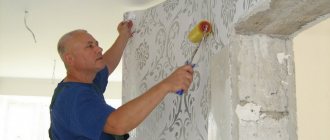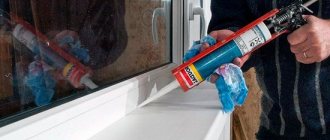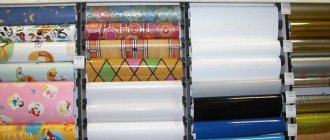Plastering walls is an integral and important stage in repair work. Its implementation and adherence to technology affects the finishing coating - attractive appearance, performance, durability. At the same time, it is not only important to understand how the process itself should proceed, but also to know which composition is applicable in a particular case. This is due to the fact that not every material is suitable for external and internal work, under high or low humidity and other conditions. Further comfort depends on what we choose.
What plaster should I use where?
Recommendations for what solution to use for plastering walls with your own hands in different rooms and different surfaces:
| Room | Material |
| bathroom | cement plaster |
| facade plaster | cement |
| kitchen work area | cement |
| bedroom, corridor, living room | gypsum, cement |
| interior ceiling decoration | only plaster |
| ceilings balcony, loggia, bathrooms | cement |
| in damp, poorly heated rooms | I recommend cement or lime plaster |
| basement with very crooked walls | mortar |
| alignment of the façade plinth | mortar |
| slopes inside | plaster |
| slopes outside | cement |
It is better to sheathe the ceilings of the balcony, loggia, and bathrooms with something. Insulate the ceiling of the balcony and cover it with cement plaster. In bathrooms, you can safely use moisture-resistant gypsum plasterboard on the ceilings. Moreover, it is easier to prepare drywall for painting. It is often called dry plaster. Bedroom, corridor, living room - if the budget is not high, then everything else is cement (except for the ceilings). If the budget is a little higher, then the residential part of the premises is gypsum plaster
These are purely my recommendations, and I use these principles to select a solution. It is impossible to say unequivocally which plaster is better, each for its own purposes. Hope this helps you.
Which plaster is better for leveling walls, gypsum or cement? The conclusion from all of the above is that it is impossible to say which plaster is better. Because each mixture is for different purposes and has its own advantages and certain properties.
Cement-sand plaster
This sand mixture is popular for repair work. The peculiarity of this mixture is that it can be used for plastering walls, but in which heating is not provided. Suitable for finishing wet rooms and building facades.
Why is such a mixture universal? The thing is that the mixture has strength, flexibility, adhesion, elasticity and frost resistance. That is why this mixture is a universal and indispensable tool for work.
Technical characteristics of plaster
Here we will talk about the main properties and characteristics of different types of plaster. Consumption, layer size under different conditions, drying time and much more.
Plaster consumption
Consumption:
- The average consumption of gypsum mortar is 9 kg per 1 m2 with a layer thickness of 1 cm. The cost of 30 kg is approximately $6
- The average consumption per square meter of cement composition is on average 15 kg with a layer thickness of 1 cm. The cost is approximately 25 kg - $2.5
- Consumption of lime material per 1 m2 is on average 12 kg with a thickness of 1 cm. Cost 35 kg - 1.5$ Cost of cement for a bag of lime - 0.5$
I think it will be useful for you to know how much plaster costs, at least approximately. In terms of price, it’s up to you to decide what is more profitable for you and what is more convenient to work with for this price. But as for the choice, I will help you come to this conclusion now. And so, you must decide what work is being performed and where, what your budget is (low, average or above average).
Minimum and maximum layer
| material | minimum layer |
| gypsum rotband knauf | 5mm, in practice 2mm |
| cement plaster | 5 mm, in practice 3 mm |
| Lime plaster | 10mm |
| material | maximum layer |
| gypsum rotband knauf | 50mm |
| cement plaster | 20 mm < reinforcement required |
| Lime plaster | 7 cm with reinforcement |
Shelf life of plaster
If stored correctly, the shelf life of the dry gypsum mixture is 6 months. As for cement, practice shows that if stored correctly, it does not lose its properties for a very long time. But if it has absorbed moisture from the air and become hard in the bag, then you can safely throw it away.
How long does it take for plaster to dry?
Gypsum begins to set in 45-60 minutes if you mix it correctly in clean water. Complete drying occurs after 2 weeks. The cement mixture on a brick wall with a 2 cm layer begins to set after 4 hours. Lime plaster can set differently depending on the amount of cement in the mix. It may set in 30 minutes, or maybe in a couple of hours. How long does it take for plaster to dry before applying putty? You can continue work after complete drying and visual evaporation of moisture from the leveled surface. But complete drying and hardening of cement and lime mortar occurs after 1 month.
The drying of plaster mortars directly depends on the humidity and temperature in the room; as a result, the drying time may vary.
Storing material on the balcony
It is not recommended to store dry mixture on the balcony for two reasons:
- At night, the temperature drops, and in winter, storage conditions in general are greatly violated.
- high humidity or excessive dry air.
The material should be stored in bags strictly according to the instructions indicated on the packaging. By the way, I also don’t recommend storing it in the basement for a long time. In general, I do not recommend storing leftover material and storing it. There is a very high probability that the remains will have to be thrown away over time.
Making your own plaster
After studying the ratio of ingredients, you can prepare your own solution for leveling the walls. The proportions of lime plaster are as follows: 1 part lime paste, 3 parts sand. The proportions can be slightly changed if the fat content of the lime is excessive or insignificant. Thus, for one part of lime you may need from 1 to 5 parts of sand. After combining the ingredients, the composition should be mixed, gradually adding liquid and sand.
DIY plaster mixture
With a limited budget for construction or renovation, you have to think about saving. Choosing plaster here is easy: you can save on finishing costs if you make cement-based compositions yourself. It's really cheaper, although it requires additional time and effort. But remember that additives are added to the finished compositions to improve the properties of the plaster. For example, antifungal additives are added to formulations for wet rooms to prevent the development of mold. In compositions for plastering external walls, an additive is added to the antibacterial ones to increase frost resistance. There are also plasticizing additives that make application easier. In principle, you can also add these additives to homemade plaster. You can find them at construction markets or in specialized stores; the standards are written on the packaging. And even taking into account the cost of additives, the savings when making it yourself will be significant - about 30%.
Proportions of plaster compositions for different application techniques
It’s not difficult to make cement-sand or lime-cement plaster with your own hands. Mix the components in certain proportions in dry form, then add liquid components (if any and water), bring to a certain consistency. You can mix it manually with a shovel in a large basin or trough. You can mechanize the process if you have a drill - using a special attachment. The easiest way is using a concrete mixer. With it, things go faster, but large volumes are difficult to produce, especially if you have little experience.
Cement-sand mixture: proportions
The cement-sand mixture is made up of 1 part M400 or M500 cement and 3-5 parts sand. The cement must be fresh, the sand must be dry, sifted through a fine sieve with a grain size of no more than 1.5 mm. Take 0.7-0.8 parts of water. As you can see, the proportions are approximate. Sand can be of different humidity levels, mortar can be used for plastering walls in different rooms, cement can be of different brands. When choosing the amount of water, the main guideline is ease of use. It is necessary to select the composition so that it is not so thick that it falls off the wall, but not so liquid that it slides. This is determined experimentally.
Working with DSP is not easy
There is also a difference in composition depending on the area of application. To plaster exterior walls, take 3-4 parts sand to 1 part cement. To level the walls indoors, more sand is added - 5 parts or even more.
Although DSP is much cheaper than ready-made mixtures, it is more difficult to work with - it does not stick to the wall very well, it takes a long time to dry, and when dry it almost always becomes covered with cracks. But it is not afraid of moisture and for this reason it is recommended for plastering walls in damp rooms, which will subsequently be finished with tiles or wall panels (PVC, MDF or any others). For other types of finishing - painting, decorative plaster and wallpaper - it is better to use cement-lime mortar or gypsum.
DIY cement-lime plaster mortar
Cement-lime plaster is made with the addition of lime paste. Parts of lime are measured out in the form of a dough, then diluted with water to a liquid state and in this form added to thoroughly mixed dry cement and sand.
The proportions of cement-lime plaster are as follows: for 1 part of cement take from 1 to 2 parts of lime paste, 6-9 parts of sand. Water is added to bring the solution to the desired consistency. The sand is the same as for DSP - with a grain size of no more than 1.5 mm, the water is clean, without contamination. Lime dough is better than store-bought. When extinguishing at home, there are still particles that have not reacted. Later, when the wall gets wet, they react and increase in volume, which causes pieces of plaster to fall out. Therefore, it is better not to save on this.
Cement-lime mortar is more plastic, but less durable
The exact selection of proportions is determined experimentally: the mass should stick well to the wall. Walls in any premises can be plastered with a cement-lime composition. The composition is softer, more convenient to work with, and does not crack when dry. But the strength of such plaster is much lower than DSP and this must also be kept in mind.
Good gypsum plasters
The most popular gypsum plaster is Rotband from Knauf. This is a really high quality product that is easy to use even for beginners. The same company has other products - Goldband and HP Start. They are cheaper, and the quality is quite decent.
The most popular type of plaster is Rotband.
NR Start is a gypsum-lime composition, Goldband is a gypsum composition. The difference between Rotband and Goldyuand is the thickness of the minimum layer. Rotband’s is 5 mm, the second’s is 8 mm. Otherwise, the technical characteristics are very similar - both consumption (8.5 kg/m3 with a layer thickness of 1 cm), and maximum layer (50 mm), and compressive and bending strength. The density in the hardened state differs slightly: ~980 kg/m3 for Goldband and 950 kg/m3 for Rotbabd. Scope of application: any residential and non-residential heated premises, including kitchens with bathrooms.
| Name | Purpose | Color | Layer thickness | Binder type |
| Knauf Rotband plaster mixture | For plastering smooth surfaces of walls and ceilings | White gray | 5-50 mm | Gypsum with polymer additives |
| Plaster-Adhesive Mixture Knauf Sevener | For restoration of old plaster surfaces, including facades | Grey | Portland cement with polymer additives and reinforcing fibers | |
| Plaster Bergauf Bau Interier | For plastering in rooms with normal humidity | Grey/White | 5-40 mm | Cement with polymer additives and perlite filler |
| Plaster Volma-Canvas | For indoor spaces with normal humidity | 5-50 mm | Based on gypsum with chemical and mineral additives |
Volma Layer, Osnovit Gipswell, Eunice Teplon, and Prospectors also speak well of gypsum plaster. They cost less, give good results, but it’s still easier to work with Rothband and the “company”. Based on the results of working with these brands, there are both positive and negative reviews, but in general, the quality is not bad.
Specifics of plaster compositions
Since buildings need to be plastered outside and inside, where the finishing is exposed to different conditions for a long time, the compositions of plastering solutions are also specific. Facade surfaces are subjected to more severe mechanical stress, are watered by rain, hit by hail, endure frost and heat, and are scorched by direct sunlight. Therefore, solutions for external conditions should be more resistant to all these “troubles”.
There are mixtures for facades, interior work and universal ones. The latter can be equally used for outdoor and indoor decoration.
All basic data on the proportions of plaster solutions for exterior and interior decoration are contained in the table from the standard.
spray and soil during external and internal plastering
The following figure shows the proportions of the covering.
cover - proportions
Composition of mortar for plastering external walls
Mortars for external walls differ in their base. Gypsum and lime compounds are not used for exterior finishing. An exception is plastering of closed loggias and balconies, where there is protection from water ingress. Therefore, the main binder for facade compositions is cement. Cement-lime (popular) and cement-polymer (more expensive) compositions are also used.
Clay is not afraid of frost and sunlight. But clay plaster must be protected from erosion. For facades in regions with a dry climate, if water does not directly fall on the plaster, plastering with lime-clay and lime-gypsum mixtures is used.
Increased mechanical loads (impact and abrasion) require increased strength of the plaster coating. Therefore, high grade cements are used (not lower than M500). In areas with high vibration loads (for example, near railway tracks), it is better to use cement-polymer mixtures.
As for outdoor mortars for plastering walls, the proportions of the compositions used in temperate climates are as follows:
- cement (with plasticizer) – 1: 6;
- cement-lime (lime as a plasticizer) – 1: 1: 6;
- dry masonry cement mixture (already contains plasticizers) – 1:5.
For harsh climates:
- cement (with independent addition of plasticizer) – 1: 4;
- cement-lime (see above) – 1: 0.5: 4;
- cement-masonry mixture – 1:3.
Composition of plaster for interior work
As for materials for indoor work, mixtures on any basis are suitable. The proportions are shown above. It should be taken into account that plasters have different vapor permeability, which means that for bedrooms, children’s rooms, and living rooms it is better to use those that “breathe” better.
It is advisable not to use gypsum and lime mixtures without special protection for bathrooms, toilets and wet basements.
For interior work, gypsum mixtures are most often used for leveling. Composition: 6 parts gypsum + 2 water + 0.2 PVA.
Which plaster to choose for leveling walls
You can achieve perfectly smooth walls using drywall, special solutions or plaster. The choice of option depends on personal preferences and is determined by the material from which the walls are made. To level out large uneven areas, it is better to use plaster with a cement or lime base. To finish walls with small potholes and cracks, another plaster is used to level the walls:
- silicone - consists of mineral fillers, silicone resins and pigments, can be used in any room;
- acrylic - includes mineral components and acrylic resins, is prone to flammability, and therefore is not suitable for leveling walls in the kitchen and in areas with high temperatures;
- silicate - a universal mixture consisting of mineral filler, pigments and liquid glass, provides high quality coating;
mineral - the most budget option, allowing you to achieve a unique decorative surface, contains cement, lime and marble chips.
Plaster is used in the process of finishing a room. It is needed to level walls, hide depressions and cracks, seal seams between masonry, etc. Before wallpapering, the walls must be treated with plaster. Otherwise, due to the uneven surface, the wallpaper will overlap each other or, conversely, a gap will appear between the joints of the two canvases. In addition, plaster has good thermal insulation properties - it does not let cold air into the room and does not let warm air out.
Sometimes plaster is confused with putty. Putty and plaster are very similar in properties, but there is a significant difference - plaster is used to level walls with a large curvature and in appearance it is similar to facade plaster, since it contains filler. And then putty is applied to smooth out the grainy texture of the plaster.
Which plaster is best for apartment walls? This question cannot be answered unambiguously, because when choosing a coating, it is necessary to take into account the material of the walls (concrete, brick walls) and in what conditions the plaster will be used (high humidity, normal temperature conditions, etc.). There are several types of plaster based on composition: gypsum, cement, lime, clay. Plasters with gypsum and cement are more practical. Sometimes the binding elements are combined: lime mass is added to the cement-sand mortar.
Rating of the most popular mixtures for interior work
A rating based on the opinions of experts and buyers will help you choose the optimal plaster for leveling walls.
The best cement plasters
Most buyers choose Knauf "Grunband". Suitable for those who want to choose plaster for both interior and exterior work. Masters note very economical consumption.
ru.weber, ceresit.ru, plitonit.ru
- Weber Vetonit Universal application, wide range of thicknesses, quick drying. The downside is that in dry rooms additional moisture is required for the first couple of days.
- Ceresit CT 24 Light. Consumption is 20-25% more economical than analogues. Has excellent adhesion, suitable for rooms with high humidity.
- PLITONIT T1+. Frost-resistant and durable. Very economical consumption - about 7 kg per 1 sq. m.
The best cement-lime plasters
Among them are the following:
ek-group.ru, td-perel.ru, kreps.ru
- EK Chemical TT50. Suitable for indoors and outdoors, for all surfaces. Plastic, with high thermal insulation properties. The downside is that it can only be applied manually.
- Perel Robust-M. Universal product for machine application. You can achieve a smooth surface without puttying.
- "Creps Extra-Light". Budget. Applicable on different surfaces both manually and machine-operated. Further puttying is required.
Rating of gypsum plasters
In the ranking of gypsum plasters, the leader is Knauf “Rotband”. The plastic mass is easy to work with, it does not roll, has good adhesion, and does not require a finishing coating. The disadvantages are the high price and the presence of fakes.
ru.weber, volma.ru, profmarket74.ru
- Weber-vetonit "Profi Gypsum". Material for machine plastering, wide range of thicknesses - from 5 to 50 mm.
- "Volma Layer". Budget. Thanks to mineral additives, it dries quickly, the layer is durable and resistant to mechanical stress.
- Unis Teplon - suitable for interior work in dry rooms. Forms a smooth white coating that does not require putty.
Which plaster is better: dry or wet?
To understand which plaster to choose for the walls in an apartment (dry or wet), you need to understand the properties of all types of coating. Dry plaster is called drywall. The wet method of leveling walls is done using plaster mortar. In this case, the thickness of the coating is adjusted depending on the unevenness of the surface. Each type of wall decoration has its pros and cons.
Drywall consists of three layers: cardboard, a layer of gypsum, cardboard. Dry plaster is used not only for leveling walls, but also for constructing suspended ceilings, partitions, door and window slopes. Advantages:
- ease of installation;
- strength;
- versatility;
- environmental friendliness.
Among the disadvantages are the possible appearance of cracks, lack of resistance to steam and water, difficulty in attaching pictures, shelves, etc. on a plasterboard structure.
Wet plaster is also called monolithic plaster, because after the mixture dries, a perfectly smooth coating without joints remains on the wall. This type of finishing takes more time than installing plasterboard sheets. The master manually applies the finished mixture over the wall and levels it until it hardens. Advantages of wet plaster:
- does not “eat up” space, as drywall does. Dry plaster is fixed in blocks of a certain thickness, while the thickness of wet plaster can be controlled;
- durable. The service life of such plaster ranges from 15 to 30 years. With proper care, the coating will remain in its original form;
- resistance to mechanical stress. If handled carelessly, dents may appear on drywall; this does not happen with plaster;
- moisture resistance. Wet plaster is not afraid of water and steam, so it can be used to level walls in the bathroom and kitchen.
Application process
To ensure the quality of the plaster layer, a certain sequence is required. Let's look at them below.
Preparing the base
Before laying the plaster, the surface must be prepared, that is, old paint, wallpaper, etc. must be removed from the surface to be treated. In addition, all surface defects must be repaired - cracks, potholes, and crumbling areas must also be treated. Ideally, the surface should be smooth and clean before installation.
Damaged areas are identified by simple visual inspection. To detect hidden defective places, you can knock on the wall with a hammer and if during tapping a dull knock is heard, this indicates the presence of damage.
In these places it is necessary to remove a layer of material; if the holes are deep, then you can lay a reinforcing mesh in them, or simply fill them with nails.
Before laying the plaster, the surface must be prepared, that is, old paint, wallpaper, etc. must be removed from the surface to be treated.
Installation of beacons
Beacon - this guide piece is necessary to guide the rule when leveling the plaster layer. Their use allows you to save up to 30% of the solution, in addition, the work is significantly accelerated. Various methods are used to secure them. The lighthouse itself can be either a galvanized metal profile, or specially made parts, they are called “ears”.
When installing beacons, you will need to use a grueling construction tool, preferably a laser.
Beacon - this guide piece is necessary to guide the rule when leveling the plaster layer.
Preparation of cement mortar
Of course, it is impossible to carry out the work without a ready-made solution; to prepare it you will need the tools listed above. The composition of the solution depends on the operating conditions. For example, a composition with proportions 1:1:6 and 1:2:9. We are talking about cement, lime milk and sand.
The composition of the solution depends on the operating conditions.
Plastering depending on the wall material
The solution is applied in several layers; this can be done manually or using mechanized means. The first layer is called spray, its thickness should be 5 mm. After it dries, a primer layer is applied; it is denser and makes up the base thickness of the entire coating. To ensure a smooth surface, a third layer, called an overlay, is applied. The thickness of this layer is no more than 2 mm.
The solution is applied in several layers; this can be done manually or using mechanized means.
Plaster mortar applied to a wall or other surface creates a reliable barrier to moisture. In addition, it is not susceptible to the effects of biological damage. The low level of thermal conductivity allows you to save costs and thermal energy.
Which plaster is better for plastering walls?
When a renovation takes place in a room, sooner or later the question arises: “Which plaster is best for plastering the walls?” To understand this issue, it is necessary to find out the advantages and disadvantages of various types of plaster.
According to its purpose, plaster is divided into:
- simple - ordinary plaster, with which the walls are leveled for further gluing or painting;
- decorative - used as a finishing touch for walls; it can also level surfaces with small grooves, depressions, and irregularities;
- special - contains particles that change the properties of the mixture. Thus, when barite concentrate is added, the plaster becomes X-ray protective, and if liquid glass and quartzite are added, an acid-resistant mass can be obtained.
Simple plaster, in turn, is divided into several more types depending on the binder:
- cement and sand. The proportions of the main components may vary, depending on the purpose of applying the mass. It has a rough surface, so after drying, a layer of putty is applied to it;
- lime. It is easier to work with such plaster due to the plasticity of the mixture, so the time for applying plaster to the surface is significantly reduced. Cement is present in the mass in small quantities (up to 10%). This is reflected in the strength of the material;
- gypsum. Gypsum plaster does not have waterproof properties, so it is better not to use it in the bathroom. It dries out quite quickly. This property must be taken into account when choosing the amount of dry mixture for dilution with water.
Disadvantages of gypsum plaster
If you are faced with the question of which plaster is better, then perhaps you should think about whether to purchase a gypsum composition, since it has many disadvantages. Among them it is worth highlighting: low viability, instability to mechanical stress, as well as moisture. You will have to work out the prepared mixture within 40 minutes, which requires professionalism and special skills from the master. Gypsum compositions are not used for external work, as they are not resistant to atmospheric influences.
Choosing the best plaster by manufacturer
As experts recommend, you should not purchase mixtures that are made by little-known manufacturers. The most popular products on the modern market are those supplied by the German company Knauf. It produces high-quality mixtures, and the price of these products is slightly higher compared to domestically produced goods. Among the latter, Osnovit, Yunis, Volma and Kreps have proven themselves. The quality of “Prospectors” is not inferior to Knauf. But if you purchase a large batch, the difference per package of 30 kg can become noticeable.
The influence of the thickness of the plaster layer on the drying time.
The thickness of the applied plaster has the greatest influence on the duration. Its meaning can be considered a key point and should be focused on first.
So, working with concrete and reducing its layer twice, the hardening time is reduced by 30%. And when working with wood, under the same conditions, drying is shortened by about 40%. From which it follows that taking into account the material with which repair work is carried out is by no means important.
Particular attention should be paid to the correct implementation of preparatory measures, which involve the creation of an exclusively dry base.
How long after plastering can I putty? As a rule, the final drying of the initially applied layer may require a fairly long period of time of about 20 days. However, forcing the work may result in cracking of the plaster and the resumption of the process from its first stages, which is why you should not rush if you want to achieve high quality.
